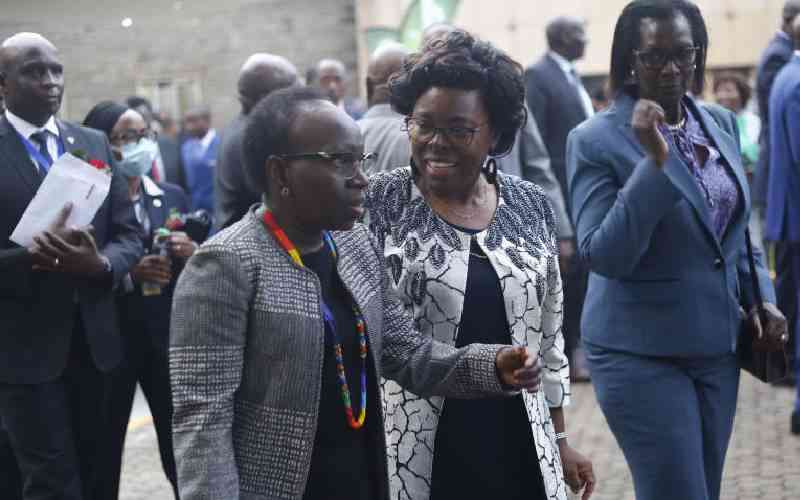Every time you log into your Facebook account, Mark Zuckerberg and all the Facebook shareholders make millions of shillings. In the third quarter of this year, 2.45 billion people used Facebook on a monthly basis. Out of this, 1.62 billion were active daily users. Because of this huge numbers, Facebook’s revenue was nearly Sh1.8 trillion during this quarter. This is more than a half of Kenya’s Sh3 trillion budget this year. The science behind it is simple – numbers.
This is what the East Africa Community (EAC) has lost. Although we are a 150-million strong market, we simply don’t use these numbers to our advantage. I dare say that the reason we don't have lots of money in circulation is either outright theft at the Treasury, or we are not innovative in the way we trade. Paying suppliers owed by the Government is not the ultimate solution to boosting our economy because the same suppliers have already lost major opportunities as their payments were delayed!
Sample this, regional trade in Africa stands at a lowly 17 per cent, while it is 64 per cent at the European Union. This means that Europe trades within itself three times more than Africa trades within itself. Although several factors account for the trade disparity, the European Union taps fully into its common market of half a billion people. Despite having more than twice the population of the European Union, Africa barely scratches the surface of intra-Africa trade. Of course things may change with the engagement of the African Continental Free Trade Agreement.
Because charity begins at home, the East African countries must whack everything that seems to delay the value proposition that created the EAC. Once we choose to focus on the spirit that envisioned EAC, without fear or favour to any member state, we will create millions of jobs for our desperate youth.
Don't have easy access
Allow me to ask, have you ever heard of Uduseke, Rwanda’s famous, expertly woven baskets? I doubt it; this is because they are hardly available in Kenya. This robs thousands of skilled Rwandan artisans who make these dazzling baskets their golden chance of earning millions from potential buyers in Kenya. In the same vein, millions of buyers in Tanzania do not have easy access to Uganda’s plenteous bananas. This deprives thousands of Ugandan farmers a harvest of Tanzanian shillings.
Although Uganda regained its position as the leading buyer of Kenyan goods after spending Sh61.9 billion in 2018, we can easily double this number within two years. This can be done through policy guidelines because efficiency and rapid growth of a member state must be rewarded. We are all in a lucrative economic race and may never be at par with each other.
Anyway, as we work towards more exports from Kenya to the region, we should not compromise quality as recently experienced when Rwanda suspended import of Kenyan products such as peanut butter, paracetamol and maize flour. East African leaders must end this needless disputes because they bleed jobs.
Notably, last week in Arusha, the EAC hosted the Global Manufacturing Industrial Summit. It delved into manufacturing, industrialisation and investment in the region. These three are cornerstones of intra-regional trade. A manufacturing base is critical. It’s easier for Burundi to buy passion juice from Rwanda than passion fruits. But for that juice factory to be established, investors must come calling guided by our policies and decent politics.
Good infrastructure is also key. How else will the juice be transported to Burundi from Rwanda if the transport infrastructure is wanting? Can’t we therefore slam the door shut in the face of corruption and build a high-speed railway network that will cover the whole region within two years?
Remember that EAC legislation for fostering trade in the region is already in place and we just need to implement it religiously. Policies like the East African Community Customs Management Act, common external tariff and rules of origin are legislative tools that we should constantly update to build vibrant intra-East African trade.
Valid reasons
Thankfully all is not lost. In 2018, intra-EAC trade grew to Sh606.5 billion, from Sh554 billion in 2017, which marks a growth of almost 10 per cent.
Friends, we have 150 million valid reasons to move from plan to action unless we want to simply become crying babies. Let’s think and act green for common prosperity.
– The writer is founder and chairperson, Green Africa Foundation. www.isaackalua.co.ke
Stay informed. Subscribe to our newsletter
 The Standard Group Plc is a
multi-media organization with investments in media platforms spanning newspaper
print operations, television, radio broadcasting, digital and online services. The
Standard Group is recognized as a leading multi-media house in Kenya with a key
influence in matters of national and international interest.
The Standard Group Plc is a
multi-media organization with investments in media platforms spanning newspaper
print operations, television, radio broadcasting, digital and online services. The
Standard Group is recognized as a leading multi-media house in Kenya with a key
influence in matters of national and international interest.
 The Standard Group Plc is a
multi-media organization with investments in media platforms spanning newspaper
print operations, television, radio broadcasting, digital and online services. The
Standard Group is recognized as a leading multi-media house in Kenya with a key
influence in matters of national and international interest.
The Standard Group Plc is a
multi-media organization with investments in media platforms spanning newspaper
print operations, television, radio broadcasting, digital and online services. The
Standard Group is recognized as a leading multi-media house in Kenya with a key
influence in matters of national and international interest.








